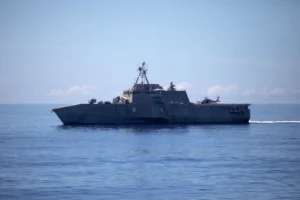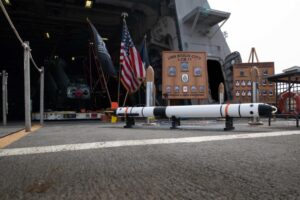The Navy may potentially send Independence-class Littoral Combat Ships to the Middle East for mine countermeasures (MCM) missions, officials said last week.
The service aims to send up to two Independence-class ships to Bahrain with a version of the LCS MCM mission package by 2025, Marine Brig. Gen. Marcus Annibale, director of expeditionary warfare at the Chief of Naval Operations’ staff (OPNAV N95), confirmed during a panel at the Surface Navy Association’s annual symposium on Jan. 11.

“So the plan right now, and it could change depending on combatant commander warfighter requirements, the delivery right now is 2025 to CENTCOM and 2027 to [INDOPACOM],” Annibale told reporters following a panel discussion at the symposium.
He said using the Independence-class ship for this mission is part of the program of record.
The Navy had previously planned to send Florida-based Freedom-variant LCSs to operate in the Middle East region, but the Navy has been looking to decommission most of the Freedom-class early due to a flaw in the combining gear design requiring fixes and delays leading to a cancellation of the anti-submarine warfare mission package they were set to primarily field.
The odd-numbered Freedom-class LCS are built by Lockheed Martin [LMT] and shipbuilding partner Fincantieri Marinette Marine, while the even-numbered Independence-class is built by Austal USA.
The West Coast-based Independence-class LCSs have been working to certify the MCM mission package for several years and are also developing an expeditionary MCM capability.
Annibale said the MCM mission package “is on the cusp” of reaching initial operating capability following trials with it on the USS Cincinnati (LCS-20), with no “red flags” evident.
The mission package includes the MQ-8C Fire Scout, unmanned surface vehicles and unmanned underwater vehicles as well as either additive capabilities that will be bundled and introduced over time, Annibale said.
However during the panel, Annibale said the Navy is also looking to potentially send the Freedom-class LCS to the region first due to local infrastructure issues while they have the opportunity to use some MCM detachments.
“There’s some concern with Independence-class that as we move that, our goal is 2025 to put it into CENTCOM – the infrastructure of Bahrain may not quite be right for Independence-class. The Freedom-class may be a good vessel of opportunity…to mate those packages together with some of those capabilities.”
Annibale said the Navy may send the LCSs over with some MCM mission package components and Explosive Ordnance Disposal (EOD) units. The ships would use capabilities like the Lionfish Unmanned Undersea Vehicle (UUV) with EOD to perform MCM missions.

Annibale said the Lionfish can detect mines down to about 1,000 feet currently, “and we think may be able to go deeper.”
“Mate those 2 capabilities together into a formation to do the mission, in lieu of a deliberate programmed MCM mission package going through the whole [initial operational test and evaluation]test process,” he continued.
Rear Adm. Brandan McLane, Commander of Naval Surface Force Atlantic, said during the panel how the Navy has been experimenting with expeditionary MCM capabilities on Freedom-class ships.
He noted in the last year the Navy deployed the Freedom-class USS Sioux City (LCS-11) to the U.S. 5th Fleet and 6th Fleets with its main surface warfare package but also an expeditionary MCM detachment.
LCS-11 deployed with 30mm gun, a 1-meter rigid hull inflatable boat, an MH-60S Sea Hawk helicopter, and an EOD expeditionary MCM package with remotely operated undermanned underwater vehicles for minesweeping (Defense Daily, Oct. 5).
“One of the big advantages of the LCS is it has a big mission bay. You can put a CONEX box in it and that’s exactly what they did. They put a CONEX box in it with a whole bunch of toys and then then played with them,” McLane said.
He said the Navy learned a lot from that deployment and plans to repeat the experience with another Freedom-class ship in the same configuration.
“It’s not program of record stuff, but we’re going to learn a lot moving forward,” McLane added.
Rear Adm. Fred Pyle, director of surface warfare on the CNO’s staff (OPNAV) N96, also told reporters the Navy still plans to put Naval Strike Missiles (NSM) on all the remaining LCSs, the six Freedom-class LCSs will perform the surface warfare mission, and 15 Independence-class ships will perform the MCM mission.
The Navy is also looking into the idea of MCM motherships with vessels like Expeditionary Sea base ships (ESBs) deploying unmanned vehicles.
Annibale told reporters he sees Independence-class as a prime example of an MCM mothership along with ESBs.
“ESBs are being looked at for those kinds of capabilities. There is no firm requirement for motherships,” Annibale said.
Pyle confirmed there are no strict limits on motherships deploying MCMs, but the Navy is looking at all options.
“We’re going to broaden our aperture very wide to look at all options, all options on the table for what’s the art of the possible from motherships,” Pyle said.